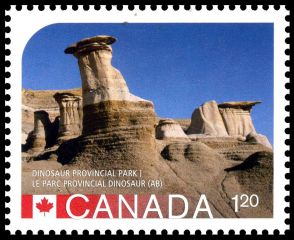Canada 2015 "UNESCO World Heritage Sites" (self adhesive booklet)
| <prev | back to index | next> |
| Issue Date | 21.08.2015 |
| ID | Michel: Stanley Gibbons: UPU: Category: pR |
| Author | Lara Minja, Lime Design |
| Stamps in set | 5 |
| Value | CAD 1.20 - Dinosaur Park in
Alberta - corrected image CAD 1.20 - Red Bay Basque Whaling Station in Newfoundland and Labrador CAD 1.20 - Wood Buffalo National Park in Alberta and Northwest Territories CAD 2.50 - Kluane/Wrangell-St.Elias/Glacier Bay/Tatshenshini-Alsek Parks in Yukon CAD 2.50 - Alaska and Waterton-Glacier International Peace Park in Alberta and Montana |
| Size (width x height) | Stamp measures 23.25 mm x 20.25 mm; Minisheet 130 x 71mm |
| Layout | Two booklets of 6 stamps each |
| Products | None |
| Paper | |
| Perforation | |
| Print Technique | Lithography in 5 colours |
| Printed by | Canadian Bank Note |
| Quantity | 140,000 |
| Issuing Authority | Canada Post |

On July 3, 2015 Canada Post launched the third set of stamps of UNESCO World Heritage sites in Canada serie. Canada has 17 UNESCO World Heritage, five of which are included in this first set.
On July 7, Officials at Canada Post have issued a recall on a stamp featuring Dinosaur Provincial Park, a UNESCO World Heritage Site, because of a big problem.

 The error comes
from the image used on the stamp, which is of a set of hoodoos, a rock
formation found in the provincial park, located just north of Brooks,
Alberta. The problem is that the image on the stamp is actually of
hoodoos that exist east of Drumheller, a community about an hour and a
half northwest of Brooks. Canada Post has apologized for the error and
is recalling the stamps from all post offices so they can be destroyed.
A new stamp, with a correct picture, issued on August
21.
The error comes
from the image used on the stamp, which is of a set of hoodoos, a rock
formation found in the provincial park, located just north of Brooks,
Alberta. The problem is that the image on the stamp is actually of
hoodoos that exist east of Drumheller, a community about an hour and a
half northwest of Brooks. Canada Post has apologized for the error and
is recalling the stamps from all post offices so they can be destroyed.
A new stamp, with a correct picture, issued on August
21.Dinosaur Provincial Park, in the badlands of southeastern Alberta, contains some of the most important fossil discoveries of more than 40 dinosaur species dating back to the Late Cretaceous Period, 75 million years ago. The retreat of the last ice age about 13,000 years ago created the Red Deer River Valley, along with the hoodoos, isolated mesas and low-lying coulees of the badlands. It also left the Earth’s greatest concentration of Late Cretaceous dinosaur fossils. Since digging began in the 1880s, more than 300 dinosaur skeletons have been pulled from a 27-kilometre stretch along the Red Deer River. These remains can be found in museums around the world. For more details please clIck here
References
Canada Post, Philately news.| <prev | back to index | next> |